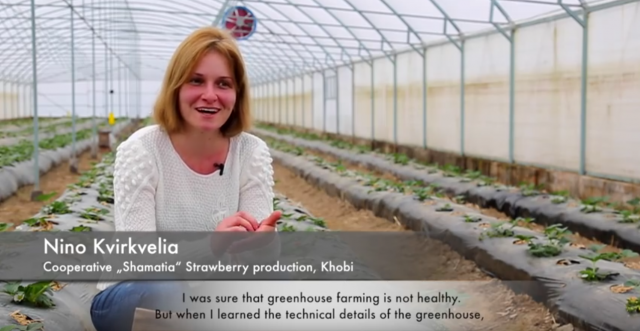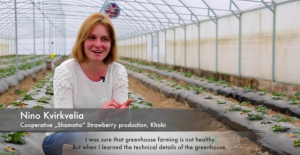The Shortest Road to the Strawberry Field Isn’t Always the Sweetest, or the Quickest
By Irakli (Rati) Kochlamazashvili and Eric Livny
The ISET Economist, a blog about economics in Georgia and the South Caucasus by the International School of Economics at TSU (ISET)
Nino Kvirkvelia and her husband Irakli Todua are not exactly your typical Georgian smallholders. Both spouses are well-educated (both hold economics and business degrees from reputable Georgian institutions). More importantly, in the context of Georgian agriculture, the couple owns 28(!) hectare of arable land in Georgia’s horticultural heaven, Samegrelo, best known for its hazelnuts. This is a fantastic amount considering that the average size of agricultural plots in Georgia is only slightly above 1ha.
A natural born entrepreneur, Irakli was among the first Georgians to benefit from a government-subsidized loan in 2013 and venture into the then-new bay leaf nursery business, which has since become a Cinderella story of Georgian agricultural exports. It was only natural that Irakli and Nino did not think twice when a new opportunity presented itself at their doorstep in village Guriphuli (Khobi municipality) in the form of an ENPARD consortium representative.
ENPARD, which stands for European Neighborhood Program for Agricultural and Regional Development, sought to promote agricultural cooperatives as a means of bringing the badly needed scale and efficiency to Georgia’s terribly fragmented fields. And, indeed, the opportunity was about getting some new business going in the form of an agricultural co-op, with the help of an ENPARD grant and additional support from the government’s Agricultural Cooperation Development Agency (ACDA).
The opportunity was too good to pass on, but there was literally no time to think twice (or even once); the first ENPARD messenger arrived in Khobi in March 2014, with only a few weeks remaining till the deadline of ENPARD’s “business idea” competition. The couple quickly agreed that the new business would be Nino’s to develop and manage. A refugee from Abkhazia (her family escaped the war and settled in Samegrelo when she was 9), Nino remembered her love for growing (and gobbling) strawberries. And thus her business idea was born: a modern strawberry greenhouse to compete with low-quality imports that inundate the country in the off-season period.
To qualify for an ENPARD grant, Nino invited four locals to contribute their labor to the cooperative effort. The cooperative (“Shamatia”) was formally registered with ACDA in the summer of 2014, after Nino’s business idea passed the first stage of the ENPARD competition. Given Nino’s clear leadership role and the fact that practically all assets in the cooperative’s ownership (starting with land) were contributed by Nino and Irakli, the couple acquired a controlling stake (more than 2/3) in the business, with four other members sharing the rest.
Success has many fathers…
“Shamatia” was among the first ten cooperatives selected for ENPARD’s funding and technical support. The latter included business training and expert consultations, but what mattered most for Nino, Irakli and their partners was, of course, ENPARD’s financial contribution, a so-called “recoverable grant” of about 46 thousand GEL. The term “recoverable” suggests that the entire grant amount would have to be paid back at some point in the future, but given the lack of legal and procedural clarity (pay back when, how much, to whom; sanctions in case of non-payment?), the team could get the impression that a recoverable grant is just … a grant.
ENPARD funding and Shamatia’s own contribution of 17 thousand GEL brought the total initial investment to about 63 thousand GEL, enough to build two state-of-the-art greenhouses (540 m2 each), equipped with a modern drip-irrigation system, ventilation, and heating ovens operating on hazelnut shells (as appropriate for a greenhouse built in Samegrelo). Complete with storage and drainage, a security booth, and even a mini-tractor (purchased at a 25% discount provided by ACDA), by April 2015, the two greenhouses were ready to receive the first seedlings of the “San Andreas” strawberry variety, four thousand of them.
And then the trouble started…
The locally purchased strawberry seedlings were doing just fine for the first 10 days, but then started to wilt. Many local “experts” offered their opinions and suggestions for treatment, but the four thousand San Andreas seedlings would not live another day. A post-mortem examination of the seedlings, as well as the local soil and water samples in a European laboratory, revealed that the seedlings were infected with a lethal decease. The cost of laboratory tests (€400) brought the total amount of damages to well over 15 thousand GEL, including the loss of six months’ worth of income.
Learning from Own Mistakes
This could have been the end of Shamatia, but Irakli and Nino had the financial stamina for a fresh start, this time guided not only by sweet childhood memories, but also first-hand experience and advice arriving in the form of a qualified international expert provided by the Georgian Association of Berry Producers. The entire plot under the greenhouses was disinfected. Three thousand new strawberry seedlings, about 50% of total Shamatia capacity (to reduce the risk of another grand failure), were ordered from Spain at the rather attractive price of 1.2 GEL per seedling. The second round of planting took place in October 2015, following proper preparation of the soil (mixing it with straw).
Currently, the future of Shamatia seems to be bright. The productivity of San Andreas strawberry plants peaks after two years, but the plants may last 4-5 years, allowing the team to accumulate sufficient financial resource for replanting and additional investment. While the first harvest, in February-March 2016, was rather modest, the next one, planned for March-July 2017, may reach 2 tons, i.e. about 0.5gk per seedling (compared to the maximum capacity of 1.2kg for the San Andreas variety.). Another harvest is expected in November and early December. Achieving higher productivity would require continuous harvesting during 10 off-season months through the use of heating. This, however, does not (yet) make sense in Georgia’s specific strawberry market situation.
Cooperation in marketing?
A very important business dilemma facing Shamatia is the choice of the harvesting period. Strawberries fetch the highest prices (up to 10 GEL) in winter time, yet producing during the cold season would require switching on expensive heating. Unfortunately, Shamatia’s modest production volumes do not allow it to sell through modern supermarket chains, most of which will only work with suppliers able to deliver 80-200 kg of standardized strawberry on a daily basis. Thus, Shamatia’s only choice is to sell in the local markets (Khobi, Senaki and Zugdidi) at the much lower price of 3.5-5 GEL. At this price point, there is no reason for Shamatia to switch on an expensive heating system and expand the harvesting period.
Importantly, a small farming enterprise may be locked into this kind of “bad equilibrium;” in the absence of resources to expand production volumes to meet modern retail (and certainly export) requirements, small farms (and small production cooperatives) may be forever doomed to supply only the local markets, competing with each other rather than with importers.
Given the sheer size of their agricultural holdings, Irakli and Nino may be able to break out of this vicious cycle. To this end, they plan to add two more greenhouses (including a hydroponic one!) and plant open field strawberries to keep themselves busy during the warm seasons. As far as their smaller competitors are concerned, the only way out is to come together in the form of a regional marketing cooperative. For the moment, the ENPARD is supporting four strawberry production cooperatives, including Shamatia, in the Samegrelo and Guria regions, for a total of nine greenhouses. If/when all of them reach full capacity, they may be able to produce 15-25 tons of strawberries, enough to qualify for a lucrative, long-term supply contract with Georgian supermarket, hotel or restaurant chains. Making this dream become a Georgian reality will require a lot of planning and coordination, not to mention real agronomical expertise and business calculation.











